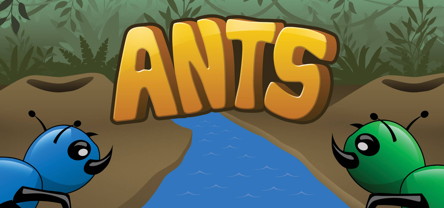|
There were new people near us in camp last night, and they were up until 1am talking
and laughing loudly even though quiet time is 11pm. That was the first time we'd had a
problem with noise in our campground. Other than that, it had been pretty quiet at night,
other than the occasional animal howling or screeching.
Today was pack-up day. Check-out is 11am, and we made it out just before that. Today we'd
be driving the famed Icefields Parkway down to Lake Louise Campground in Banff National Park.
It's about 3 hours of driving if you don't stop, but nobody does it without stopping, at least
not the first time.
We headed south along Highway 93 and shortly came to our first stop, Athabasca Falls. It's
a very short walk from the parking lot to the falls, and then there's a myriad of paved trails on
either side of the falls and above and below the falls. We explored pretty much all of these
trails. The falls themselves are not very tall, only about 80 feet tall. However, the flow of
water is tremendous. It is pretty impressive. It starts out wide and quickly narrows before
widening out into a relatively peaceful river after the falls. If you go at the right time,
you should have no problems spotting a rainbow in the falls. We saw one over the falls when
we were at the lookout on the far side of the falls, just above it (around noon).
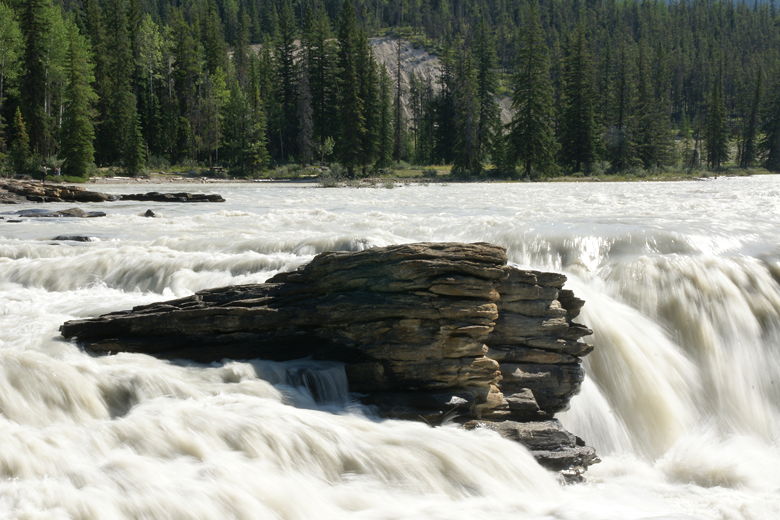
Top of Athabasca Falls
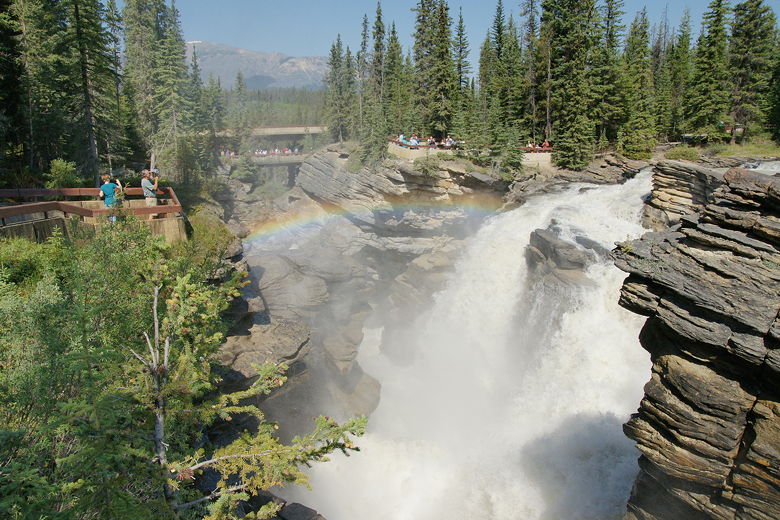
Rainbow at Athabasca Falls
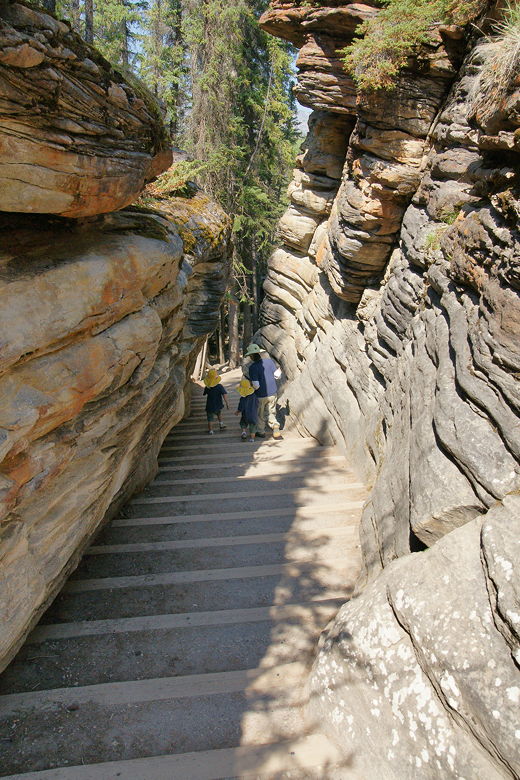
Heading down narrow staircase to bottom of falls

Athabasca River below the falls
Since we spent so much time at Athabasca Falls, we decided to skip Sunwapta Falls. I did stop
at a few roadside pullouts because the view of the glaciers on the mountains to the right were
too good not to stop for. Despite all my stops we finally did make it to the Icefield Centre,
just on the other side of the road of the Athabasca Glacier.
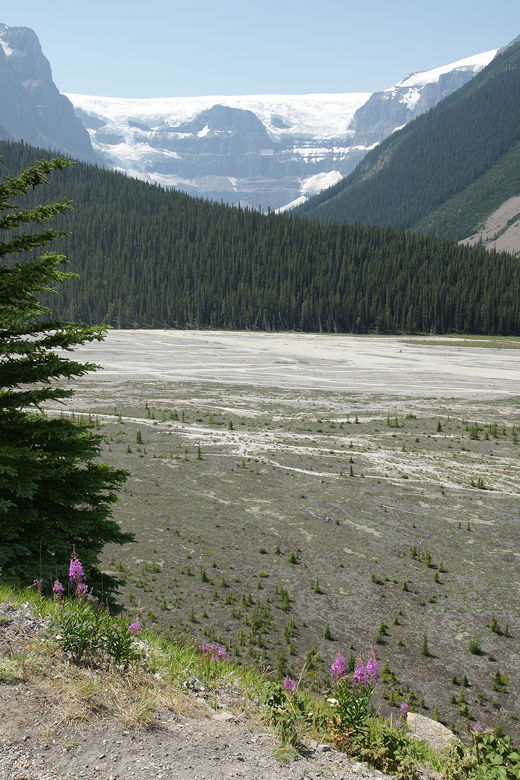
One of the glaciers visible from the Icefields Parkway
The Icefield Centre is a large building with food, interpretive displays, and is a place to buy
tour tickets. There are picnic tables next to the large parking lot, and we grabbed one to eat
our lunch. Despite being within minutes of the glacier, it was rather warm out. Well, the
glaciers are receding so perhaps that's no surprise.

Athabasca Glacier as seen from the Icefield Centre
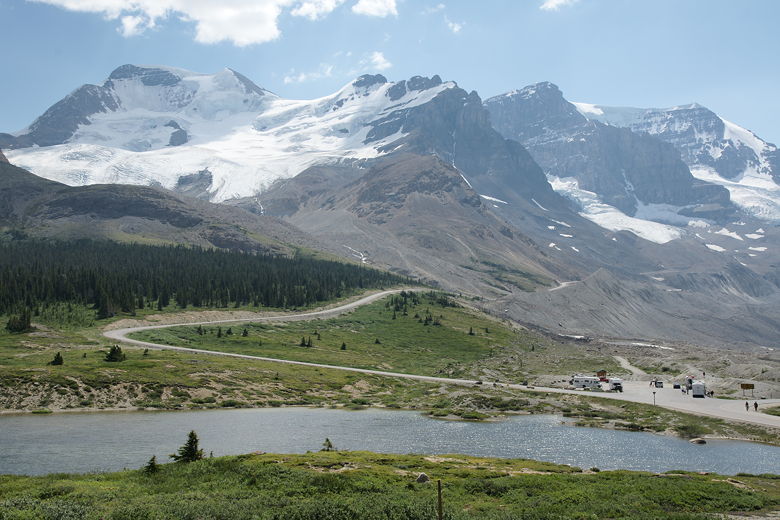
Mountains to left of Athabasca Glacier
After lunch we went inside and bought tickets for the bus tour onto the glacier. It's
expensive ($46 for adults and $23 for kids 6-15), but at least kids 5 and under are free if
they sit on your lap. A half hour later,
we were boarding a bus headed up toward the glacier. Less than 10 minutes later, we transferred
from the bus to a snow coach, a special bus with huge wheels made for going onto the glacier.
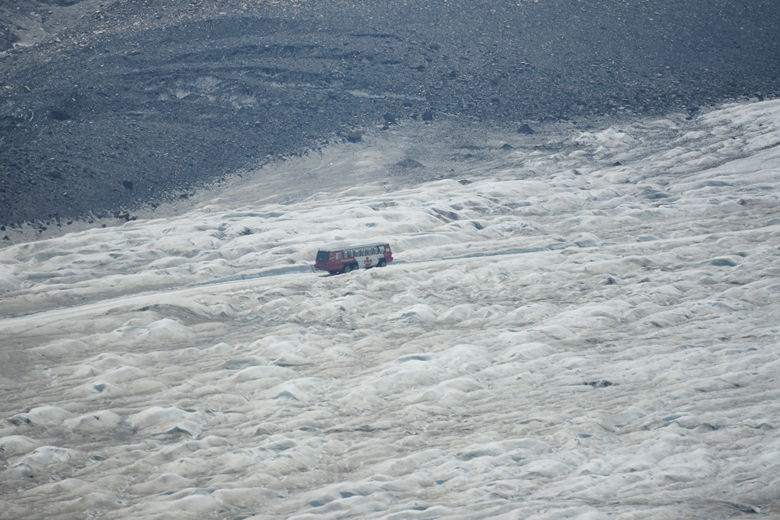
Tour bus on the Athabasca Glacier
While we headed up the glacier, our driver and guide gave us some facts about the glacier and
the busses. There are only 22 of these special busses in the world, and 21 of them are owned
by the tour company. The other is in Antarctica with a research team. The bus went down
a steep 32% incline before we started heading up the glacier. It's hard to tell when you
actually make the transition onto the glacier because gravel covers the end of the glacier.
You think you're on the ground, but beneath you is a glacier. The tour company has carved out
a path to a large, flat, stable area of the glacier, coned off so you can stay in the safe zone.
You wouldn't want to fall into a 40-foot deep crevasse now, would you?

Looking up at the Columbia Icefield from on top of the Athabasca Glacier
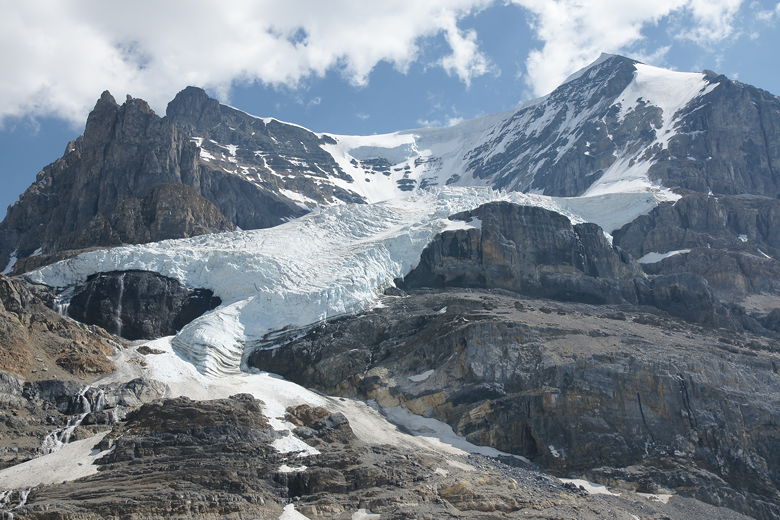
Glacier on one of the mountains to the left
The glacier is actually up to 1000 feet thick in places. It's part of the huge
Columbia Icefield, which our guide described as being the size of Vancouver. The icefield
feeds several glaciers, of which the Athabasca Glacier is just one. Despite standing on a giant
ice block, it wasn't all that cold. Many people wore shorts. Think spring skiing in Tahoe.
It did get a bit windy, though. At the turnaround point we were able to get out and walk around
on the ice for about 20 minutes. If you do the tour, you might want to bring along a cup or
bottle so that you can
drink the water melting from the glacier.

Tourists on the Athabasca Glacier
Our kids really enjoyed taking the ice bus. But as we took the bus back down the glacier, I
suddenly realized that our kids may not be able
to bring their kids to enjoy this same experience. The glaciers are retreating at an
alarming pace. In the late 19th century, the glacier reached all the way to the road just in front of
the ice centre, 1.5 kilometers away from its present edge (or "toe"). By the time our kids are
old enough to take their kids, the glacier will be much smaller still. It's a sobering thought.
So if you go, make the most of your opportunity. I like to say that you can turn around from
a mountain hike because the mountain will always be there. The same cannot be said for glaciers.
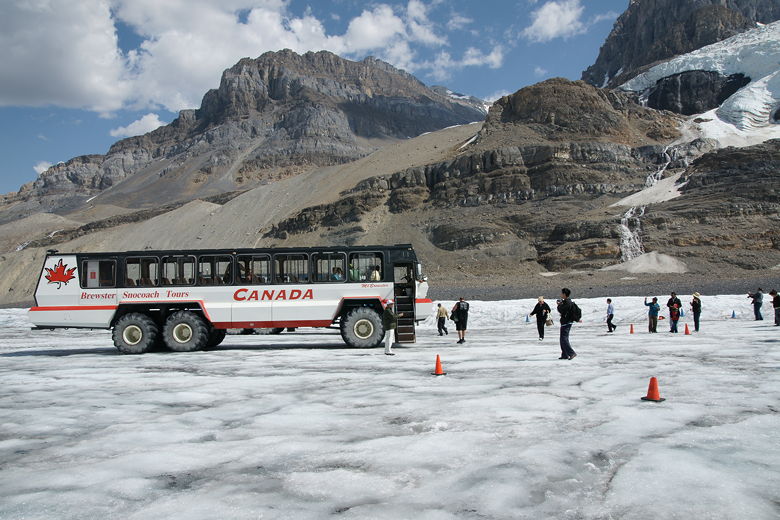
The ice bus
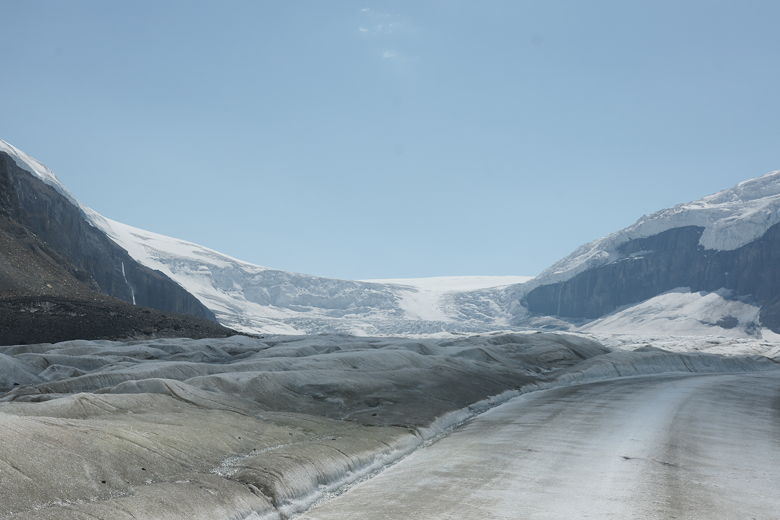
Looking back from the back of the bus
The tour lasted a little less than an hour and a half in total. Afterwards, we decided to do
the short hike to the toe of the
Athabasca Glacier. Most people would probably either opt for the bus tour or the hike, but not both, but
we had a little time and, as I said, I was thinking we won't get many opportunities here.
The other option is to take a guided hike up onto the glacier. Companies will outfit you with crampons
and take you up onto the glacier on your own two feet. Of course, that wasn't a realistic
option for us with two small children.
After the hike we got into the car and continued the drive south. It's a beautiful drive with more
glaciers and some beautiful lakes visible from the road. I normally would have stopped several
times to take pictures, but it was getting late and
we wanted to get to our campground. I did note that Bow Lake looked gorgeous, and I'd use
that information later when deciding on a hike.
By the way, while the Icefields Parkway is a very nice drive, I still think I'd have to give
Trail Ridge Road in Rocky Mountain National Park in Colorado the nod as perhaps my favorite
park drive. Still, I was a bit annoyed that I hadn't yet bought something like the
VHoldR ContourHD video camera so that I could attach it to the dashboard and take a video of
the drive. I'm pretty sure I'll cave in and buy it or something like it soon.
We arrived at the Lake Louise shopping center around 7pm. We bought some ice and groceries,
then proceeded a short distance to the Lake Louise campground. Once again, you can't reserve
specific sites; they assign sites to you. Even though I had a reservation, I still had to
wait several minutes before the line of cars in front of me went on. I should consider myself
lucky, though -- that line of cars was much longer the next morning.
They have the same campfire permit process at the Lake Louise campground that they have at the
campground in Jasper. We purchased two permits for campfires. Again, all the firewood you
want is provided. One unique aspect of the campground at Lake Louise is that it's
encircled by an electrified fence that was put in place in 2003. The fence is to prevent
bear-human interaction. It may be to keep the bears out, but sometimes looking at the yellow
tape it's hard not to feel like it's meant to keep the people in.
When we arrived at our campsite, we were a bit miffed to find someone
already parked there. Apparently it was a guest of one of the nearby campers, and she'd parked
in our site. She took her sweet time moving her car, never saying anything to us or
even acknowledging us (her friend had told her that we were waiting). We waited patiently
before we could finally park and start setting up our camp.
After dinner we had our first campfire of the trip. Sunset is a little earlier here than
in Jasper, so quiet hour is 10pm instead of 11pm. Noise from other campsites was not a
problem. However, we did have to get used to the sound of freight trains running at night,
blasting their horns.
| 












